Baptism in Broad-mindedness: Saving Future Teachers from Creationism
The struggle between creationists and upholders of science is largely a war of words. Yet it is in many ways an unequal contest. Creationists have a quiver full of misleading quotes, soaring oratorical rockets, and cannonades of pseudofacts, outlandish promises, and dreadful threats. Science advocates too often come to the fray armed with a wagonload of complicated ideas, bound in knotty jargon and dragged to the lines by lead-footed prose and clunky equations. As the philosopher Dale Beyerstein has observed, “The creationist knows that his or her dogmatic assertions will appear to the lay audience as straightforward, no-nonsense presentations of the facts; in contrast, the scientific opponent will appear obfuscating and evasive.”
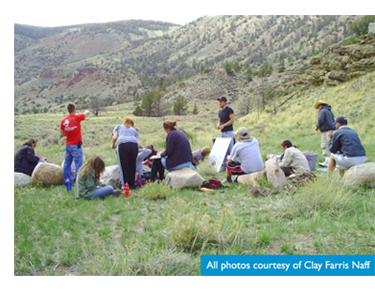 What would happen if the pro-science side quit trying to win over young people with words and instead let them discover science for themselves? That is what geologist David Harwood, holder of the Stout Chair in Stratigraphy at the University of Nebraska-Lincoln (UNL), decided to find out. Together with his former doctoral student, Richard Levy, he has created a unique geology field course for future teachers. The idea is simple: In the rocky wilderness of Wyoming, a dozen students are pressed into teams and tasked with recapitulating centuries’ worth of geological discovery in a matter of days.
What would happen if the pro-science side quit trying to win over young people with words and instead let them discover science for themselves? That is what geologist David Harwood, holder of the Stout Chair in Stratigraphy at the University of Nebraska-Lincoln (UNL), decided to find out. Together with his former doctoral student, Richard Levy, he has created a unique geology field course for future teachers. The idea is simple: In the rocky wilderness of Wyoming, a dozen students are pressed into teams and tasked with recapitulating centuries’ worth of geological discovery in a matter of days.
“I want to teach classes that make a difference,” Harwood tells me. In his early fifties, bearded, balding, and soft-spoken, he nevertheless conveys the vigor and determination of a younger, hungrier man. His research in Antarctica, where he leads an international coring project, has added to the mountain of evidence that global warming poses dire threats. But the inability of many Americans to distinguish between scientific evidence and political hogwash dismays Harwood. It has led him to redirect his energies into nurturing science-savvy teachers for the next generation.
He obtained initial funds from the university’s geology alumni association, got a two-year National Science Foundation grant, received a starter endowment for the class from Marlys Christiansen (the widow of a geologist who got his start at UNL), and is now pursuing additional resources to continue the class indefinitely. Harwood believes that by allowing young teachers to experience scientific discovery for themselves, he can spark a generational revolt against today’s widespread disdain for science.
Research published recently by Randy Moore and Sehoya Cotner suggests that he is on target. Their study in the May 2009 issue of Bioscience indicates that high school teachers have a decisive influence on the acceptance or rejection of evolution in young people’s minds. Unfortunately, they also find that at least a quarter of science teachers fall short in the teaching of evolution.
Many of the same issues are implicit in geology: the scientific narrative too often fails to capture the attention and respect of students, who go on to be college-educated creationists. To counter this trend, Harwood shelves the hand-me-down narrative and has the students construct one of their own. They stitch it together out of the fabric of their own observations and deductions.
The results are nothing short of astonishing. Replace passive learning with engagement in the process of scientific inquiry, and profound changes come over students. Just as geological discoveries in the late eighteenth and early nineteenth centuries gave rise to the Darwinian revolution in science, so the first-hand discovery of earth history inscribed in rock opens up young minds—even if they’ve been indoctrinated by religion. In May 2009 I accompanied the class on its trek across Wyoming and witnessed the transformation as it unfolded.
* * *
I’m hunched in the stern of a motor boat that’s skimming across the choppy waters of Alcova reservoir. Waves explode into icy showers each time the bow dips. The students, braver than I, are leaning into the spray. Alison, a tall crew athlete, leans into the spray like a carved mermaid on a ship’s prow. To distract myself from the impending nausea I’m prone to when moving on water, I gaze off into the red hills that cup the lake. Stands of hardy juniper cling to their sides. It strikes me that if Mars is ever terraformed, it will look at lot like this. But then we head into a canyon that splits the red rim, and suddenly we’re no longer floating in an imaginary future but slogging up a channel into an immense past.
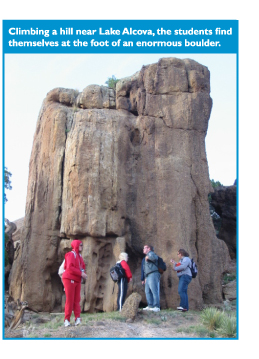 The students gaze in wonder at the canyon walls. Layer upon layer of rock formation, each as distinct as notes in a scale, tower above them. Gradually, with gentle prodding from their professor, the students develop a narrative history of the canyon. It’s clear, for starters, that the bottom layer is composed of huge blocks of crystallized magma. On this foundation are layers of sedimentary rocks laid down by winds or waters. Much of this appears to be compacted dust but occasionally there is a layer of something that looks like cake frosting. At certain points on the expedition, they find evidence of a violent upwelling of blackened magma. It shoots up through the layers like black lightning. With a little professorial prompting, they figure there must have been an early volcanic upheaval followed much later by a lesser eruption.
The students gaze in wonder at the canyon walls. Layer upon layer of rock formation, each as distinct as notes in a scale, tower above them. Gradually, with gentle prodding from their professor, the students develop a narrative history of the canyon. It’s clear, for starters, that the bottom layer is composed of huge blocks of crystallized magma. On this foundation are layers of sedimentary rocks laid down by winds or waters. Much of this appears to be compacted dust but occasionally there is a layer of something that looks like cake frosting. At certain points on the expedition, they find evidence of a violent upwelling of blackened magma. It shoots up through the layers like black lightning. With a little professorial prompting, they figure there must have been an early volcanic upheaval followed much later by a lesser eruption.
Not a bad start for a bunch of neophyte geologists. They are a differing dozen, ranging in age, major, sociability, worldview, and familiarity with science. At one end of the spectrum is Emily, a former microbiology doctoral candidate who has decided to become a science teacher instead. Her commitment to science is complete, but even she will find this inquiry-based curriculum a challenge. If Emily is ultraviolet, then at the other end of the spectrum—somewhere in the infrared—stands David, an evangelical Christian who proudly declares himself a young-Earth creationist. The others are strung between them. There’s Ben, red-haired, proudly Irish-American, raised a Catholic but more inclined to give primacy to science. There’s Laura, a free-spirited creationist who is trying to make science fit into her faith. There’s Joe, tall, stoic, and a staunch Catholic who believes that science fits well within the framework of Vatican theology. There’s Chelsea, who’s a spiritual explorer but a bit of a science-phobe, and among others there’s Tatiana, who is more interested in partying than praying.
Early on, however, they are united by one thing: frustration. Despite their modest success at deciphering the canyon, the students find Harwood’s zen-like pedagogy puzzling. As they stare at a rockface, he intones another scientific sutra: “You’ve got to think about what’s there, and also what was there … but isn’t there.”
“He’s got a Ph.D.,” one of the students mutters sarcastically. “He must be right.”
Back on dry land, the students try again to get the hang of this discovery thing. Investigating a hill near the Cottonwood Creek Dinosaur Trail, they attempt to decode the uptilted layers that poke their edges out of the incline. They are hobbled by an ignorance of terminology. “Oh my God!” exclaims Tatiana. “I feel like I’m freakin’ five years old!” Ben, however, is beginning to see virtue in direct inquiry. Caked in dirt as red as his hair, he shows me a handful of soil he has excavated. “I call it ‘green shaley stuff.’ We don’t know the names of anything! But that’s okay.”
He suddenly turns philosophical. “You can’t just accept what someone says—or even what you think. You have to try out different ideas.”
Ben doesn’t know it, but he has just stumbled onto geologist T. C. Chamberlin’s precept of multiple working hypotheses, one of the key nineteenth-century contributions to the modern scientific method. The name means nothing to him, but the idea of investigating and testing various possible explanations sticks. Within a few days, virtually the entire class has caught on. Pooling their observations, making up a lexicon, generating hypotheses, and applying systematic if sometimes faltering analysis, the group begins to succeed at deciphering the geological history before them.
“We’re learning by discovery,” Harwood tells the students, adding encouragingly, “You’re reading the landscape and making inferences. That’s good.”
The experience has turned Tatiana around. “At first, I was really frustrated,” she reflects. “I’m like, ‘just give me the answer! But now I see that it wasn’t about finding the answers, it was about the process of asking.” Learning to read the rock has definitely strengthened her commitment to science. “If I had to choose between faith and science, at this point, I’d go with science,” she proclaims.
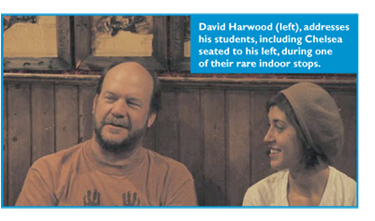 Chelsea, slim, dark-eyed, and thoughtful, admits that although early on she wandered away from her Christian roots, until now she has “avoided science and math like the plague.” To her, science always seemed like a boring set of claims imposed on students from above. “It’s all presented to you as knowledge handed down from this professional class of scientists,” she says. “You feel like you just have to learn and regurgitate it.”
Chelsea, slim, dark-eyed, and thoughtful, admits that although early on she wandered away from her Christian roots, until now she has “avoided science and math like the plague.” To her, science always seemed like a boring set of claims imposed on students from above. “It’s all presented to you as knowledge handed down from this professional class of scientists,” she says. “You feel like you just have to learn and regurgitate it.”
Drawn neither to Christianity nor science, Chelsea has sought to find a center in her life through Native American mysticism. Having some Chicasaw heritage herself, she has been especially drawn to the writings of Vine DeLoria Jr., a Native American creationist. In the midst her immersion in field experience, however, she is giving science a second chance. “This is totally different,” she declares. “I’m starting to feel like I can really do this!”
* * *
One student takes a bit longer to come around, and his “conversion,” when it occurs, is decidedly more ambiguous. Nevertheless, to observe what happens to David during the first ten days of the inquiry course is to see the remarkable power of Harwood’s teaching methods.
At the outset, David strikes an ostentatiously defiant pose. Long before I learn that he is a creationist, it’s apparent that he’s trying to set himself apart. He crosses his arms and scowls a lot. When others sit down to listen to Harwood, he stands. Out in the field, he repeatedly sticks a hayseed between his teeth, as if daring anyone to call him one.
Most notably, he hits on the stratagem of referring to his professor as “Doc.” (As in Bugs Bunny chomping on a carrot and wisecracking, “Ehhh, what’s up, Doc?” We all know who was the smart one in that encounter.)
When I first have a chance to chat with David, by a roadside cut, he tells me right off, “I’m basically in this course for giggles and credits,” adding that that chance to camp for three weeks was for him the big draw. David is cut out for it. Lean and muscular with a vulpine grin, he endears himself to the group at camp by producing an axe and chopping firewood like a frontiersman.
In a follow-up interview, he lets me know that he was raised in a large evangelical family and attended a fundamentalist Christian school. “I’m a little more open-minded than my family,” he notes. Then, in case I leap to the wrong conclusion, he adds, “I’m a stark conservative.”
It soon becomes clear that everything he knows about science comes from the standard creationist cant. He brushes Harwood’s idea of science aside as “a lot of this’s and that’s. It all comes down to one word—theory.” It turns out that his main objection in this class is to the geological column, which sets the Earth’s age at billions of years. “It’s a hypothesis that can’t be proven or hasn’t been proven,” he says. “It’s not a fact.” To avoid the possibility of heresy, David avoids writing any dates at all in his field journal.
And yet, within a week, David’s mind opens up to new ways of thinking, and he becomes a vigorous advocate of the inquiry method of learning. That is not to say he drops his lifelong commitment to fundamentalist Christianity. That would be too much to expect. But change washes over him all the same like a baptism in broad-mindedness.
He becomes aware for the first time that there are Christians who accept the scientific account of geological and biological evolution. He is surprised to learn that Joe, the staunch Catholic, is completely at home in science. “He has the idea that the days of creation were eras,” David tells me, “and that evolution is part of God’s plan.” He begins to turn these ideas over in his mind.
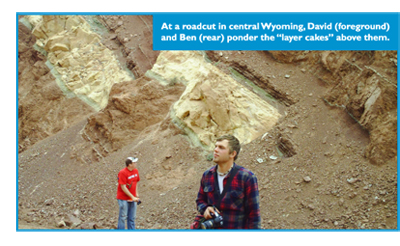 Exposure to Wyoming’s astonishing geological sites really jazzes him. For all his rigid upbringing, David proves to be a keen observer with a supple mind. On the first day of the journey, he refused even to talk about fossils. But after finding some of his own, he’s become an enthusiast. When it comes time for the students to plan a lesson (they will do some practice teaching at a middle school on their return journey through Nebraska), David is all for employing the inquiry method in the classroom.
Exposure to Wyoming’s astonishing geological sites really jazzes him. For all his rigid upbringing, David proves to be a keen observer with a supple mind. On the first day of the journey, he refused even to talk about fossils. But after finding some of his own, he’s become an enthusiast. When it comes time for the students to plan a lesson (they will do some practice teaching at a middle school on their return journey through Nebraska), David is all for employing the inquiry method in the classroom.
Over the objections of Emily, the former lab researcher who is surprisingly resistant to the concept, David insists that the students should get some hands-on experience with fossil formation. He wants to engage them in making model fossils in various types of media, so they understand that fossils only form under certain conditions. He suggests students make the models in class and then take them home for the weekend to set. Remarkably, he adds, “They need to understand that there has to be time for fossils to form. A lot of time.”
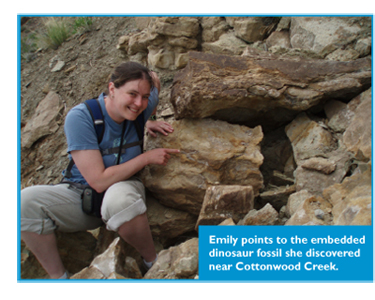 When Emily objects that they might not bring their models back, David responds with a new and respectful inflection in his nickname for their professor. “Does Doc know if we’re going to talk things over when he leaves us? You have to trust the inquiry process!”
When Emily objects that they might not bring their models back, David responds with a new and respectful inflection in his nickname for their professor. “Does Doc know if we’re going to talk things over when he leaves us? You have to trust the inquiry process!”
Later that same day, David emerges as a thoughtful leader as the group tries to solve an especially puzzling geological riddle they’ve named “Mystery Rock.” He urges them to marshal evidence for how wind or water might have affected the outcrop. He even suggests multiple hypotheses. “Did it rise from below? Was it here before the glacier or did it come down after?”
Harwood is impressed but unsure that the experience will spark a revolution in David’s life. All the same, he allows that it might. “This could be huge for him. But if it just opens up awareness and causes growth, it’s a success.”
For his part, David avers that his theological views remain unchanged. There can be no gainsaying, however, that the trip has opened new frontiers in his life. At a roadcut in central Wyoming, David notes in his field journal, “I believe this stop is where things began to click for me.”
By the time I have to take my leave of the group, on the outskirts of Yellowstone National Park, David attributes his success in reading the landscape to imitation. “I try to be like Doc,” he says, adding with an impish grin, “I might give a little more credence to what he says than before. I’d have to see more evidence to believe that the Earth is as old as they say it is.”
* * *
David, you may wish to know, intends to be a sports journalist rather than a teacher. As for those who are headed for a career in the classroom, the dawn-to-dusk discovery has bolstered their confidence in science and made them enthusiasts for Harwood’s teaching method. Emily notes that she had been in the habit of using “a lot of big words that I have heard before but my students may not understand, and [that] I am unable to explain to them. I must work on this!”
Ben says he’s ready to introduce inquiry into the classroom. If any students bring up religious objections, he plans to tell them, “It’s fine to believe in religion, but that’s not science. Even if you don’t believe it, this is what science is. While we’re in that context, how do you think this could have formed?”
For Alison, there is nothing to debate. Gazing at the Tetons, she pronounces judgment. “This is stone cold fact. You can’t look at this and deny that it’s millions of years old.”
For Dave Harwood, who left his wife and two small children at home to lead this trek, knowing that his students arrived at these conclusions on their own has made the long, arduous journey worthwhile.
